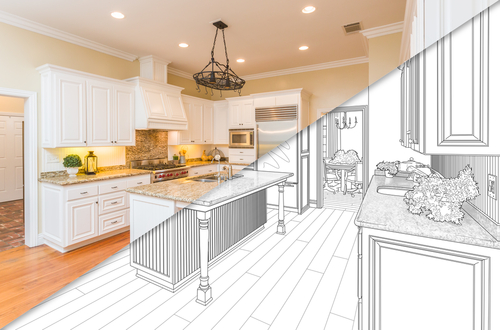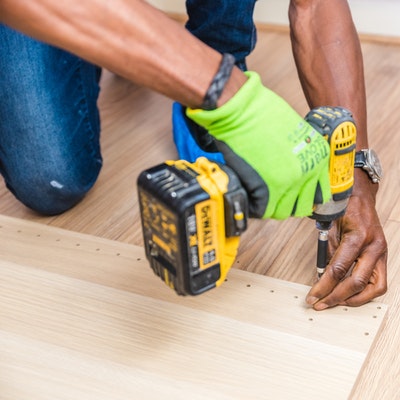Has your living space shrunk over the years? Have you grown whilst it has become smaller and more cramped? In other words, is your home no longer serving its purpose as you would wish? If the answer is a resounding “Yes!”, think carefully before turning to the ‘Properties for Sale’ pages and websites. It is far cheaper to improve rather than move, especially if you like the area you are presently living in and it is convenient for your daily life.

Why move – rather improve
It is inevitable that, over time, we tend to fill our homes with more and more clutter. It takes a very disciplined person to keep a house free of clutter and items which have outgrown their use. Sentimentality certainly has its place in our lives, but keeping items which will never be used again and are little more than dust-collectors is pointless and unnecessary. If your house has provided a happy home for you over the years, there should be no need to move simply because your family or needs have increased. It has been said that one should, ideally, move house every seven years, simply to clear out the physical accumulation which has built up over time, but this is a very short-sighted option. Most houses allow for expansion, and it is highly possible that your house can be added onto, either upwards or sideways, to provide additional space.
Can’t go sideways? Go up instead
Modern houses tend not to have large gardens, and it is sometimes not possible to add on another room when the first or second baby arrives, or when you need additional space for a professional home office. If you can’t ‘expand the waistline’ of your home’s footprint, then consider adding on an additional second floor. Admittedly, this is the more expensive option of the two, but an upper story will often give you much more value space-wise, as well as providing additional views across your immediate neighbourhood.
Use an architect to utilise the most of your space
Architects are masters at re-jigging available space to maximise usage and appeal. In older homes which were, by design and then-conventional guidelines, strictly compartmentalised into smaller, functional rooms, an architect will see the bigger picture and open up the areas into larger, more family-friendly areas which not only give the impression of a larger home, but also increase the aesthetic and light value of the house. No longer do the cooks have to be confined in one room away from family or guests when preparing meals. The modern trend now is for the kitchen to be streamlined into the living areas, allowing for open communication at all times. The downside? The kitchen should be tidy and neat all the time, especially since there is no door to close on those dirty dishes! It’s a relatively small price to pay for a larger living area where the kitchen is, indeed, the heart of the home. And it is so much easier to catch that sneaky thief who is constantly raiding the fridge and pinching the last piece of pie! With the vast array of beautiful flooring and tiles available these days, it is extremely easy to get the bespoke kitchen of your dreams, as well as a living space which draws sighs of envy from your friends and family.
Catch the sun – indoors!
Many modern homes have additional sun-rooms which provide warm, cheerful places to enjoy the sun, even if there is a gale blowing outside. The notorious south-easter winds in the Cape can make it very unpleasant to sit outside during the summer months, but a glass-walled sun-room will provide all the sun you need without those pesky winds blowing smaller articles off tables, whisking away paper napkins and tipping over umbrellas in the middle of your gathering. Many people use their sun-rooms as modified greenhouses, growing more delicate plants which need the sun but are unable to withstand the winds that summer inevitably brings with it.
Don’t want a permanent wall? Use partition walling
It is worth remembering that dividing a room into smaller areas need not be a permanent change. If your children are sharing a large bedroom but constantly fighting over ‘ownership rights’ to the communal space, erect a drywall partition wall which will keep the peace without permanently altering the room. When it is no longer needed – hopefully before the children have left home – it is easy enough to remove without leaving a constant reminder of its previous existence, and without the effort of knocking down brick walls. Partition walls can be used in many different areas of a house – to create a reading nook, a small home office, a mini-library, a study or hobby room, for instance. They can be designed to include concealed lighting or alcoves for displaying treasured ornaments. They can add architectural elements such as bulkheads and arches at a fraction of the cost of building with bricks.
Let your home adapt with you
It is normal for our personal tastes to change over time as our characters develop, and it is expected that our home surroundings will reflect these changes. Who can honestly say that furnishing and building styles which you loved twenty years ago still appeal to you now? Unless we are stuck in a time-rut, very few of us have not adapted to more modern trends and materials as we have matured and our needs have changed. Your home should reflect your individuality and the different phases of your life, and these will obviously change over the years. Don’t leave your beloved home behind you on your journey through life – take it with you wherever possible and save yourself money, effort and time. For more ideas on how to modernise your home and the materials you can use, see our various categories on Uptasker.

